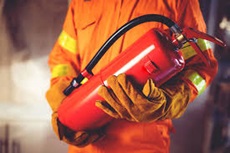
Fire safety is a critical aspect of protecting yourself, your loved ones, and your colleagues from potential disasters. With the prevalence of fires in various settings, everyone needs to have a basic understanding of how to prevent and respond to emergencies effectively. Fire safety training equips individuals with the necessary skills and knowledge to handle such situations calmly and efficiently. By learning these essential skills, you significantly reduce the risk of harm and ensure that everyone knows what to do in case of a fire. Here are nine fundamental abilities that everyone should acquire to be prepared for emergencies.
- Fire Hazard Recognition
The first and foremost skill is being able to identify potential fire hazards. This includes recognizing sources of ignition, such as faulty electrical outlets, gas leaks, and improperly stored flammable materials. Regularly checking your environment for these hazards can prevent fires from starting in the first place. Apply for a training course to learn more about potential hazards.
- Understanding Fire Alarm Systems
Knowing the difference between various fire alarms and understanding their significance is crucial. Different tones or signals can indicate different types of emergencies, and understanding the evacuation protocol associated with each can save precious time in an actual fire.
- Emergency Planning and Drills
Creating and practicing a fire evacuation plan is vital. Familiarize yourself with all exits and escape routes, and participate in regular drills to ensure that you and those around you can exit the building safely and swiftly in the event of a fire.
- Proper Use of Fire Extinguishers
Learn the correct technique for using a fire extinguisher, known as PASS (Pull, Aim, Squeeze, Sweep). This involves pulling the pin, aiming at the base of the fire, squeezing the handle, and sweeping from side to side until the fire is out. It’s also important to know the different types of extinguishers and which ones to use on various types of fires.
- Fire Blanket Usage
A fire blanket can be used to smother small fires and protect yourself from flames. Training will teach you how to wrap it around a person to extinguish flames and avoid burns.
- Fire Hose Operation
In larger buildings, there may be fire hoses available for use. Knowing how to connect them to a water supply and control the water pressure can help contain a fire before it spreads.
- First Aid and CPR
Fire safety training often includes basic first aid and CPR skills. Being able to provide initial care to burn victims or those who have inhaled smoke can be life-saving before emergency services arrive.
- Fire Door Operation
Fire doors are crafted to prevent the spread of fire and smoke. Knowing how to correctly open and close them can protect escape routes and prevent the fire from spreading throughout a building.
- Communication and Leadership
In emergencies, clear and calm communication can make a huge difference. Training will help you develop the skills to guide others safely out of a burning building and report the fire effectively to emergency services.
Fire safety is not just about knowing what to do when a fire breaks out; it’s about being proactive in preventing fires and being prepared to respond swiftly and appropriately when they do occur. By applying for a training course, you can acquire the essential skills needed to handle emergencies confidently. These skills are invaluable and can be the difference between a minor incident and a catastrophic event. Don’t wait for a fire to happen; take the initiative to protect yourself and others by getting trained in fire safety today. Employers, consider investing in fire safety training for your staff, as it can significantly reduce the risk of workplace fires and ensure compliance with safety regulations. Remember, knowledge is power, and in the case of fire safety, it’s the power to save lives.
Related posts:
Filing an ISF Yourself: Understanding the Importer’s Customs Process
Should You Hire Movers or Move Heavy Furniture on Your Own?
How to Streamline Your Small Business in 4 Easy Steps
4 Important Tips to Keep Your Business Office Physically Safe and Secure
How Your Business Can Benefit from Commercial Plumbing Services







I just wanted to express my gratitude for the valuable insights you provide through your blog. Your expertise shines through in every word, and I’m grateful for the opportunity to learn from you.
Your blog has become an indispensable resource for me. I’m always excited to see what new insights you have to offer. Thank you for consistently delivering top-notch content!